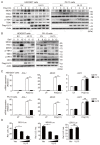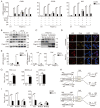Pseudorabies Virus Tegument Protein UL13 Suppresses RLR-Mediated Antiviral Innate Immunity through Regulating Receptor Transcription
- PMID: 35891444
- PMCID: PMC9317333
- DOI: 10.3390/v14071465
Pseudorabies Virus Tegument Protein UL13 Suppresses RLR-Mediated Antiviral Innate Immunity through Regulating Receptor Transcription
Abstract
Pseudorabies virus (PRV) has evolved various strategies to escape host antiviral immune responses. However, it remains unclear whether and how PRV-encoded proteins modulate the RIG-I-like receptor (RLR)-mediated signals for immune evasion. Here, we show that the PRV tegument protein UL13 functions as an antagonist of RLR-mediated antiviral responses via suppression of the transcription of RIG-I and MDA5, but not LGP2. UL13 overexpression significantly inhibits both the mRNA and protein levels of RIG-I and MDA5, along with RIG-I- or MDA5-mediated antiviral immune responses, whereas overexpression of RIG-I or MDA5 counteracts such UL13-induced suppression. Mechanistically, UL13 suppresses the expression of RIG-I and MDA5 by inhibiting activation of the transcription factor NF-κB. Consequently, overexpression of p65 promotes the activation of RIG-I and MDA5 promoters. Moreover, deletion of the p65-binding sites in the promoters of RIG-I or MDA5 abolishes the suppression role of UL13. As a result, mutant PRV lacking UL13 elicits stronger host antiviral immune responses than PRV-WT. Hence, our results provide a novel functional role of UL13-induced suppression of host antiviral immunity through modulating receptors' transcription.
Keywords: MDA5; NF-κB; RIG-I; pseudorabies virus (PRV); tegument protein UL13.
Conflict of interest statement
The authors declare no conflict of interest.
Figures





Similar articles
-
Pseudorabies virus tegument protein UL13 recruits RNF5 to inhibit STING-mediated antiviral immunity.PLoS Pathog. 2022 May 18;18(5):e1010544. doi: 10.1371/journal.ppat.1010544. eCollection 2022 May. PLoS Pathog. 2022. PMID: 35584187 Free PMC article.
-
West Nile Virus NS1 Antagonizes Interferon Beta Production by Targeting RIG-I and MDA5.J Virol. 2017 Aug 24;91(18):e02396-16. doi: 10.1128/JVI.02396-16. Print 2017 Sep 15. J Virol. 2017. PMID: 28659477 Free PMC article.
-
Paramyxovirus V protein interaction with the antiviral sensor LGP2 disrupts MDA5 signaling enhancement but is not relevant to LGP2-mediated RLR signaling inhibition.J Virol. 2014 Jul;88(14):8180-8. doi: 10.1128/JVI.00737-14. Epub 2014 May 14. J Virol. 2014. PMID: 24829334 Free PMC article.
-
LGP2 synergy with MDA5 in RLR-mediated RNA recognition and antiviral signaling.Cytokine. 2015 Aug;74(2):198-206. doi: 10.1016/j.cyto.2015.02.010. Epub 2015 Mar 18. Cytokine. 2015. PMID: 25794939 Free PMC article. Review.
-
Negative regulators of the RIG-I-like receptor signaling pathway.Eur J Immunol. 2017 Apr;47(4):615-628. doi: 10.1002/eji.201646484. Eur J Immunol. 2017. PMID: 28295214 Free PMC article. Review.
Cited by
-
Progress on innate immune evasion and live attenuated vaccine of pseudorabies virus.Front Microbiol. 2023 Mar 3;14:1138016. doi: 10.3389/fmicb.2023.1138016. eCollection 2023. Front Microbiol. 2023. PMID: 36937252 Free PMC article. Review.
-
TRIM26 facilitates PRV infection through NDP52-mediated autophagic degradation of MAVS.Vet Res. 2024 Jul 4;55(1):84. doi: 10.1186/s13567-024-01336-4. Vet Res. 2024. PMID: 38965634 Free PMC article.
-
Pathogenicity characteristics of different subgenotype pseudorabies virus in newborn piglets.Front Vet Sci. 2024 Aug 7;11:1438354. doi: 10.3389/fvets.2024.1438354. eCollection 2024. Front Vet Sci. 2024. PMID: 39170631 Free PMC article.
-
Evasion of the Antiviral Innate Immunity by PRV.Int J Mol Sci. 2024 Dec 6;25(23):13140. doi: 10.3390/ijms252313140. Int J Mol Sci. 2024. PMID: 39684850 Free PMC article. Review.
-
EtSERPIN1 binding with chicken ANXA2 is essential for Eimeria tenella attachment and invasion process.Vet Res. 2025 Jul 10;56(1):147. doi: 10.1186/s13567-025-01532-w. Vet Res. 2025. PMID: 40640951 Free PMC article.
References
Publication types
MeSH terms
Substances
LinkOut - more resources
Full Text Sources
Molecular Biology Databases
Research Materials

